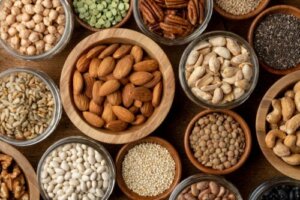The Blue Zone Diet: Can it Increase Longevity?


Written and verified by the nutritionist Saúl Sánchez Arias
The blue zone diet is based on the nutritional pattern of people living in countries such as Japan and Costa Rica, since these places have very long-lived populations. The idea is to include high-quality and fresh foods regularly in your diet, which provide sufficient amounts of essential micronutrients and antioxidants.
Before getting into the subject of the blue diet and longevity, it should first be noted that when it comes to maintaining a good state of health, it’s essential to ensure that you’re doing regular physical activity. Above all, it’s necessary to prioritize strength work. This, together with a proper diet, can be decisive when it comes to healthy and longevity.
Foods that are characteristic of the “blue zone” diet
Generally speaking, the blue zone diet is characterized by regularly presenting a series of foods on their daily menus. These foods are considered to be very beneficial to our health and are recommended by most nutrition experts.
Legumes
Legumes are an excellent source of complex carbohydrates, protein, and essential minerals. They also provide fiber, a substance that has been shown to improve the functioning of the digestive tract.
Some of this fiber ferments, thus serving as a substrate for the intestinal microbiota and preventing losses in bacterial density or diversity. This is key to maintaining homeostasis in the internal environment of the intestines.

Leafy green vegetables
Leafy green vegetables are often a source of phytochemicals. These elements neutralize the formation of free radicals and their subsequent accumulation in the tissues.
In this case, we’re talking about a mechanism that has been linked to a lower incidence of chronic and complex diseases. Although making sure you eat five servings of fruits and vegetables as part of your daily diet is recommended, emphasizing the intake of leafy green vegetables is particularly beneficial.
We think you may also enjoy reading this article: The Vertical Diet: What Is It and What Are Its Disadvantages?
Nuts
Nuts are foods with high nutritional density. They provide quality fat, protein, and a good handful of vitamins and minerals.
However, they also provide quite a bit of energy (and calories). That’s why they should be consumed daily, but always in adequate quantities.
If the doses are exceeded, a progressive accumulation of subcutaneous fat may occur. After all, being overweight increases inflammation levels, according to a study published in The Lancet.
Like this article? You may also like to read: A Vegetarian Diet for Patients with Diabetes: Tips for Planning One
So what does the “blue zone” diet consist of?
All in all, the blue zone diet is a type of dietary pattern that emphasizes the consumption of the foods we have just discussed, along with other fresh produce, such as extra virgin olive oil, barley, and blueberries. Above all, it gives priority to foodstuffs of vegetable origin, mainly because of their antioxidant content.
However, this doesn’t mean that animal products are harmful to the body. In fact, this is far from the truth. They simply must also be present in appropriate quantities to ensure an optimal protein intake.
There are no strict bases for following a blue zone diet. It will only be necessary to guarantee the proper intake of vegetables and to eat the proper amount of calories for your body weight and activity levels to ensure you don’t put on any extra weight.

The blue zone diet can help us to live longer
The blue zone diet emphasizes the consumption of foods that have proven positive properties and benefits for the body. Regular intake of many of them is associated with slower aging and a lower incidence of chronic and complex diseases.
A good state of health is the result of many healthy habits maintained over time. For example, a slightly hypocaloric diet in the medium term, good sleep, and physical training can all help you to stay healthy and live longer.
All cited sources were thoroughly reviewed by our team to ensure their quality, reliability, currency, and validity. The bibliography of this article was considered reliable and of academic or scientific accuracy.
- Gill SK, Rossi M, Bajka B, Whelan K. Dietary fibre in gastrointestinal health and disease. Nat Rev Gastroenterol Hepatol. 2021;18(2):101-116. doi:10.1038/s41575-020-00375-4
- Neha K, Haider MR, Pathak A, Yar MS. Medicinal prospects of antioxidants: A review. Eur J Med Chem. 2019;178:687-704. doi:10.1016/j.ejmech.2019.06.010
- Cox AJ, West NP, Cripps AW. Obesity, inflammation, and the gut microbiota. Lancet Diabetes Endocrinol. 2015;3(3):207-215. doi:10.1016/S2213-8587(14)70134-2
This text is provided for informational purposes only and does not replace consultation with a professional. If in doubt, consult your specialist.








